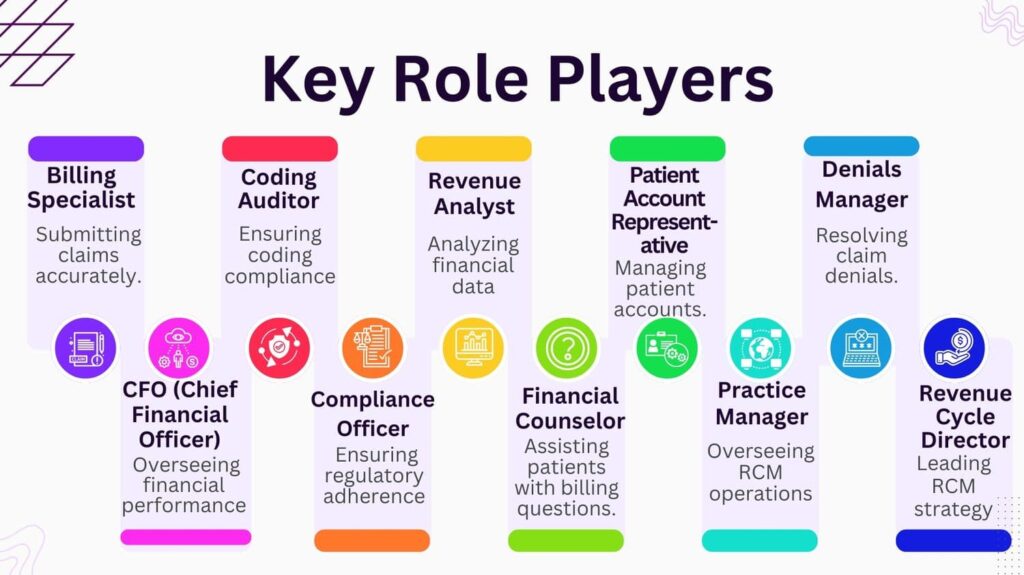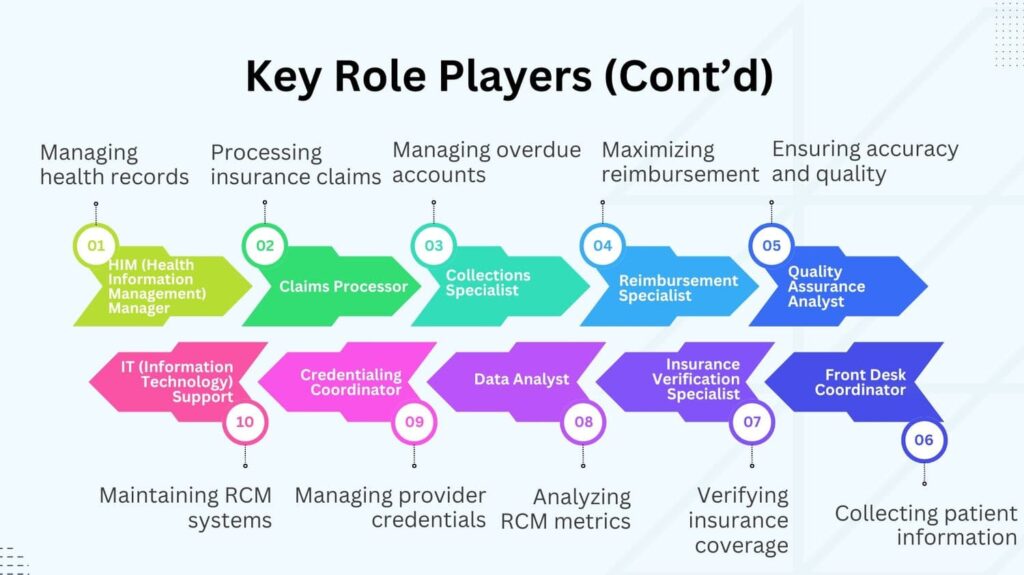Medical revenue cycle management process involves the revenue reimbursement to healthcare providers in return for their services, either from the government or either from private organizations.
The process helps medical facilities generate revenue through efficient RCM management. RCM also ensures to remove any defect that can lead to a claim denial or eventually revenue loss.
The medical revenue cycle management process starts from the scheduling of patient consultations to the recovery of reimbursement. The cycle involves the following 10 steps:
Step 1: Patient Registration
At first, the healthcare staff registers the patient consultation in the RCM program, where all of the patient’s details are filled in.
Some dos and don’ts of RCM to keep in mind from very first stage are:
| Dos | Don’ts |
| Do Verify Patient Information | Don’t Ignore Insurance Eligibility |
| Do Submit Claims Promptly | Don’t Delay Billing Processes |
| Do Conduct Regular Coding Audits | Don’t Neglect Coding Updates |
| Do Follow Up on Outstanding Claims | Don’t Overlook Denied Claims |
| Do Use Advanced RCM Technologies | Don’t Rely on Manual Processes |
| Do Train Staff Regularly | Don’t Assume Compliance |
| Do Monitor Key Performance Indicators (KPIs) | Don’t Ignore Performance Metrics |
| Do Ensure Clear Communication with Patients | Don’t Ignore Patient Billing Queries |
| Do Regularly Review Payer Contracts | Don’t Accept Underpayments |
| Do Stay Updated on Healthcare Regulations | Don’t Overlook Compliance Requirements |
| Do Implement Data-Driven Decision Making | Don’t Rely on Gut Feeling |
| Do Maintain Accurate Financial Records | Don’t Overlook Financial Reconciliation |
| Do Provide Clear Billing Statements to Patients | Don’t Use Complex Medical Jargon in Bills |
| Do Optimize Patient Scheduling | Don’t Allow Unnecessary Scheduling Gaps |
| Do Implement Robust Security Measures | Don’t Neglect Data Security |
Step 2: Attendance
The patient itself comes to take a consultation, where appointment details are collected.

Step 3: Coding
Health staff then identifies the medical RCM code according to the patient’s info.
Step 4: Claim Submission
When the reimbursement application is ready, the claim is submitted to the reviewer electronically.
Step 5: Status Tracking
Uncover the realm of RCM significance. All it takes is a press of the button.
After the claim submission, its status is constantly checked to analyze if there’s any rejection by the reviewer.
Step 6: Claim Return
The provider reviews the claim. Either he provides the reimbursement or either he denies the claim.
Step 7: If The Provider Rejects The Claim

If your medical billing claim has been denied, the revenue provider returns it by determining a problem that your staff is required to solve.
Step 8: Revenue Collection
If the claim is approved, reimbursement is made by the provider in the medical billing program.
Step 9: Bill Process
After receiving the reimbursement, the staff sends the medical bill to the patient. But mostly it is done automatically with the help of technology.
Step 10: Complete The Process
At last, health staff makes sure that patients get and pay their bills on time.
Following are some key performance indicators (KPIs) for each RCM step:
| Step Number | KPI Name | Description | Target Benchmark |
| Step 1 | Patient Registration Accuracy Rate | Percentage of accurately registered patients | >95% |
| Step 2 | Patient Check-In Compliance | Percentage of patients checked in accurately and on time | >98% |
| Step 3 | Coding Accuracy Rate | Percentage of accurately coded claims | >98% |
| Step 4 | Claim Submission Turnaround Time | Average time taken to submit claims post-treatment | <5 days |
| Step 5 | Claim Status Resolution Time | Average time taken to follow up and resolve claim status | <10 days |
| Step 6 | Claim Return Rate | Percentage of claims returned due to errors or additional information | <5% |
| Step 7 | Claim Rejection Rate | Percentage of claims rejected by payers | <5% |
| Step 8 | Collection Rate | Percentage of revenue collected from claims submitted | >95% |
| Step 9 | Billing Accuracy Rate | Percentage of accurate bills generated and sent to patients | >98% |
| Step 10 | Process Completion Time | Average time taken to complete the entire RCM process | <45 days |
These were the 10 steps involve in medical revenue cycle management that makes the process easier to conduct.

